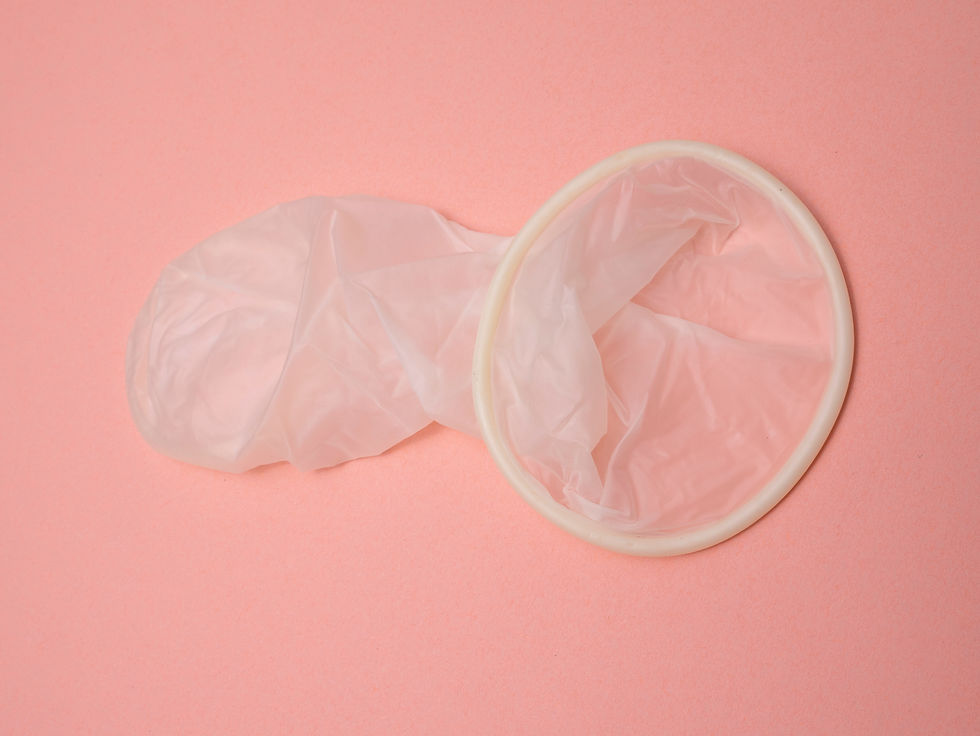Internal Condoms 101: Unknown, Unbothered, Underrated
- Raine Lovebright

- Jun 8
- 5 min read

The other day, someone casually asked me at work, “Hey, do we have any femidoms?” Cue the blank stare. Honestly, all I knew was: (a) they exist, and (b) no one ever talks about them with excitement, not in our clinic, not in most sex ed, not even in memes. Naturally, my curiosity was piqued. What is the deal with internal condoms? How is it different from a bin liner? Where have they been hiding? Are they actually useful, or just the weird cousin of the humble external condom?
So, I did what any curious queer health nerd would do: I went down the rabbit hole. And let me tell you, this underrated, baggy little barrier deserves a serious comeback.
We all know and love external condoms (aka the OG, old faithful, or as they call them in Germany, naughty bags). But did you know there’s another barrier method that’s just as fabulous, a little underrated, and super empowering? Meet the internal condom, also known as the female condom or femidom. Those names still float around, but let’s be real: internal condom is way more accurate and inclusive, especially for our queer, trans, and non-binary fam who use them.
Wait, What’s an Internal Condom Again?
Invented in 1993 (cue Spice Girls, crop tops, and dial-up internet) and available in Australia since 2000, the internal condom is a soft, roomy pouch you pop into the vagina or anus before sex. It blocks sperm from reaching the uterus and also helps reduce STI transmission.
It’s made from nitrile or polyurethane, which means it’s latex-free, a total lifesaver for our allergy babes. And get this: it’s the only receptive-partner–initiated protection that helps prevent both unintended pregnancy and STIs. Talk about putting the power in power bottom.
Despite all this, an Australian 2021 study found that in their target group of heterosexual cis women, only 2% reported using it “many times before.” That’s right, just 2%. Despite being described This little legend is flying under the radar.
How It Works (Magic + Science)
Internal condoms come with two rings (don’t worry, no wedding required):
Inner ring: Goes inside the vagina (like a tampon) and holds the condom in place.
Outer ring: Hangs out outside the body, covering part of the vulva or anus.
For vaginal sex, the penis slides right into the pouch. Simple.
And yep, internal condoms can be used for anal play too! A 2023 study from China showed they offered protection and maintained sensation for participants. For anal use, you can remove the inner ring, insert the condom manually, and let the outer ring chill outside the booty. Safe, sexy, and versatile.
Does It Actually Work?
Yep! And quite well, thank you.
With perfect use: About 95% effective at preventing pregnancy
With typical use: Around 79%, same ballpark as external condoms
STI protection: Yep, including HIV. Slightly less than external condoms, but still solid!
Why Some of Us Are Obsessed
Control is sexy: The bottom gets to take charge of safer sex. Yes, queen!
Latex-free realness: No itchy drama, just smooth sailing for our sensitive-skin babes.
Prep in advance: Slip it in hours before, no awkward pause mid-hookup.
Extra coverage: The outer ring provides more vulva or anal protection = extra safe, extra slay.
No need for a boner: It stays in place even if things get… soft. No pressure, just pleasure.
Okay, But What’s the Catch?
Less common: Not as easy to find on shelves as external condoms.
Takes practice: First time might feel a bit fiddly, don’t stress, you’ll get it.
Can be crinkly: Like a chip packet, but lube helps.
A little bulky: Some folks feel that at first, but most adjust.
How to Use It (Without Stressing)
Check the date and that the packet’s all good.
Open carefully, no wild ripping and no scissors!
Squeeze the inner ring and slide it in (like a tampon).
Push until it’s snug against the cervix; outer ring should chill outside (be careful of your acrylics).
Guide your partner in so there’s no accidental slip 'n' slide.
After sex, twist the outer ring to trap fluids and gently pull it out.
Bin it, don’t flush (seriously).
Where Can I Get Them?
Depending on where you live, you might find internal condoms at pharmacies, sexual health clinics, or online. In Australia, though, they’re still a bit niche.
As one of my friends said when I asked what they knew about internal condoms:
“Honestly, not a lot. I wouldn’t even know where to buy them. I’ve never used one either.”
Same vibe for a lot of folks. But here’s the good news: online, some pharmacies (no prescription needed!), sexual health clinics, and community orgs do stock them, and a lot of queer-friendly services offer them for free. Queer perks!
Why We Stan Internal Condoms
Internal condoms aren’t just “the other condom.” They’re a big deal in sexual health, especially for queer women, trans men, non-binary people with vaginas, and honestly anyone who is down to bottom. They let us take the reins in protecting our own bodies, with options for both vaginal and anal sex that feel affirming, not awkward.
Final Thought: Be Curious, Not Cautious
You don’t have to break up with your external condoms, but internal condoms deserve a spot in your drawer too. Try one, lube it up, get comfy with it. Like any good relationship, it takes a little practice. And hey, sex should feel good and safe, no matter your body, gender, or who you’re getting freaky with.
Got questions? Not sure where to get tested or find internal condoms? Hit up your local sexual health clinic or LGBTQIA+ health service, they’ve got your back (and your bits).
References
Fenwick, S. E., Botfield, J. R., Kidman, P., McGeechan, K., & Bateson, D. (2021). Views and experiences of the female condom in Australia: An exploratory cross-sectional survey of cisgender women. PLOS ONE, 16(2). https://doi.org/10.1371/journal.pone.0246664
Huang, J.-L., Xin, X., Ma, M.-J., Ning, Z., Xiao, S., & Chen, P. (2023). A qualitative study on the clinical safety and user experiences of female condoms for anal intercourse among men who have sex with men in Shanghai, China. Frontiers in Public Health, 11. https://doi.org/10.3389/fpubh.2023.1243891
The information provided in this blog post is intended for general educational purposes only and does not constitute professional medical advice, diagnosis, or treatment. While I am a registered health practitioner, this content is not a substitute for consultation with a qualified healthcare professional who can consider your individual circumstances.
This blog reflects my personal views and professional experiences and does not represent the views of my employer or any affiliated organisations.
In line with AHPRA guidelines, no testimonials are included, and this blog post is not intended to advertise or promote specific services or treatments.











Comments